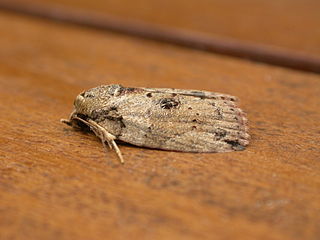
Arsacia is a monotypic moth genus of the family Noctuidae. Its only species is Arsacia rectalis. Both the genus and species were described by Francis Walker, the genus in 1866 and the species in 1863. It is found from the Indo-Australian tropics of India, Sri Lanka to Queensland and the Solomon Islands.

Dictyestra is a monotypic moth genus of the family Noctuidae erected by Shigero Sugi in 1982. It contains only one species, Dictyestra dissectus, the angle network armyworm, first described by Francis Walker in 1865. It is found from India to Indochina, Sri Lanka, China, Japan, Sundaland and the Philippines and from Sulawesi to the Moluccas and New Guinea.
Nolasena is a monotypic moth genus of the family Erebidae. Its only species, Nolasena ferrifervens, is found in India, Sri Lanka, Borneo and the Philippines. Both the genus and species were first described by Francis Walker in 1858.

Tephriopis is a monotypic moth genus of the family Erebidae. Its only species, Tephriopis divulsa, was first described by Francis Walker in 1865.
Paralbara is a genus of moths belonging to the subfamily Drepaninae.

Nanaguna breviuscula, the pigeonpea pod borer, is a moth species of the family Nolidae. It is found from Sri Lanka and India east to Samoa. In Australia it is found in the Kimberleys in Western Australia, the northern part of the Northern Territory and from the Torres Strait Islands and Queensland to Sydney in New South Wales.

Tiracola plagiata, the cacao armyworm, is a moth of the family Noctuidae. The species was first described by Francis Walker in 1857. It is found from south-east Asia, South India, Sri Lanka, Myanmar to the South Pacific Islands, including the northern two-thirds of Australia.

Somena scintillans, the yellow tail tussock moth, is a moth in the family Erebidae described by Francis Walker in 1856. It is found in northern India, Sri Lanka, Myanmar and the Andaman Islands. Though considered a minor pest, larva can sporadically be a serious pest.
Scopula emissaria is a moth of the family Geometridae. It was described by Francis Walker in 1861. It is found in India, Sri Lanka, Myanmar, Vietnam, China, Korea, Japan, the Philippines, Sumatra, Java, Wallacea and Australia.
Tigrioides sabulosalis is a moth in the family Erebidae. It was described by Francis Walker in 1866. It is found in India, Sri Lanka, Myanmar and on Peninsular Malaysia, Sumatra and Borneo.
Paralbara perhamata is a moth in the family Drepanidae. It was described by George Hampson in 1892. It is found in Northeast India including Sikkim and in Borneo.

Oreta obtusa is a moth in the family Drepanidae. It was described by Francis Walker in 1855. It is found in India, China, Myanmar and Indonesia.
Pandala is a monotypic moth genus in the family Eupterotidae described by Francis Walker in 1855. Its single species, Pandala dolosa, described by the same author in the same year, is found in Sri Lanka.
Eupterote undans is a moth in the family Eupterotidae. It was described by Francis Walker in 1855. It is found in the Himalayas.
Eupterote plumipes is a moth in the family Eupterotidae. It was described by Francis Walker in 1855. It is found in Sri Lanka.
Nisaga simplex is a moth in the family Eupterotidae. It was described by Francis Walker in 1855. It is found in Bangladesh.

Pseudojana incandescens is a moth in the family Eupterotidae. It was described by Francis Walker in 1855. It is found in Sikkim, India.
Eupterote pallida is a moth in the family Eupterotidae. It was described by Francis Walker in 1855. It is found in India.
Onebala blandiella is a moth in the family Gelechiidae. It was described by Francis Walker in 1864. It is found in Sri Lanka, India and Myanmar.
Streblote dorsalis is a moth of the family Lasiocampidae first described by Francis Walker in 1866. It is found in India, Sri Lanka, the Philippines, Borneo, Indonesia and Java.







